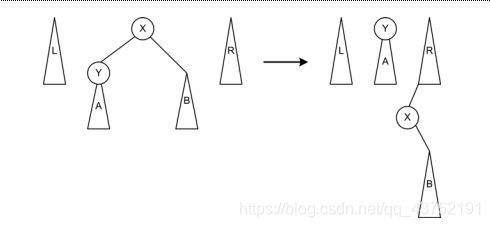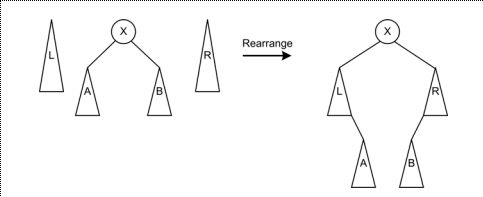手植这棵自顶向下伸展树,何时亭亭如盖呢?

前言
伸展树,解释起来真的很晕。先看一下我写的关于伸展树的理论部分吧:伸展树,据说比AVL树要简单一些。简单个球啊,写完了我还是晕晕的,所以又看了很久。
但是,总有那么一瞬,总有那么一句话,会让你茅塞顿开。
所以,我再简单讲一遍自顶向下伸展树原理,自底向上是真的,好理解,但是实现成本太高。
自顶向下原理图
说在前头
 为了叙述的方便,上图的右旋叫做X绕Y右旋,左旋叫做Y绕X左旋。
为了叙述的方便,上图的右旋叫做X绕Y右旋,左旋叫做Y绕X左旋。
当我们沿着树向下搜索某个节点X的时候,我们将搜索路径上的节点及其子树移走。我们构建两棵临时的树──左树和右树。没有被移走的节点构成的树称作中树。在伸展操作的过程中:
1、当前节点X是中树的根。
2、左树L保存小于X的节点。
3、右树R保存大于X的节点。
开始时候,X是树T的根,左右树L和R都是空的。
和自底向上一样,自顶向下也分了三种情况。
zig(单旋转)
 如上图,在搜索到X的时候,所查找的节点比X小,将Y旋转到中树的树根。旋转之后,X及其右子树被移动到右树上。很显然,右树上的节点都大于所要查找的节点。注意X被放置在右树的最小的位置,也就是X及其子树比原先的右树中所有的节点都要小。这是由于越是在路径前面被移动到右树的节点,其值越大。读者可以分析一下树的结构,原因很简单。(就这句,给我点醒了)
如上图,在搜索到X的时候,所查找的节点比X小,将Y旋转到中树的树根。旋转之后,X及其右子树被移动到右树上。很显然,右树上的节点都大于所要查找的节点。注意X被放置在右树的最小的位置,也就是X及其子树比原先的右树中所有的节点都要小。这是由于越是在路径前面被移动到右树的节点,其值越大。读者可以分析一下树的结构,原因很简单。(就这句,给我点醒了)
通了一点之后,后面就好办了。
zig-zig(一字型旋转)
 在这种情况下,所查找的节点在Z的子树中,也就是,所查找的节点比X和Y都小。所以要将X,Y及其右子树都移动到右树中。首先是Y绕X右旋,然后Z绕Y右旋,最后将Z的右子树(此时Z的右子节点为Y)移动到右树中。注意右树中挂载点的位置。
在这种情况下,所查找的节点在Z的子树中,也就是,所查找的节点比X和Y都小。所以要将X,Y及其右子树都移动到右树中。首先是Y绕X右旋,然后Z绕Y右旋,最后将Z的右子树(此时Z的右子节点为Y)移动到右树中。注意右树中挂载点的位置。
zig-zag(之字型旋转)
 在这种情况中,首先将Y右旋到根。这和Zig的情况是一样的。然后变成上图右边所示的形状。接着,对Z进行左旋,将Y及其左子树移动到左树上。这样,这种情况就被分成了两个Zig情况。这样,在编程的时候就会简化,但是操作的数目增加(相当于两次Zig情况)。
在这种情况中,首先将Y右旋到根。这和Zig的情况是一样的。然后变成上图右边所示的形状。接着,对Z进行左旋,将Y及其左子树移动到左树上。这样,这种情况就被分成了两个Zig情况。这样,在编程的时候就会简化,但是操作的数目增加(相当于两次Zig情况)。
合并树

将中树的左右子树分别连接到左树的右子树和右树的左子树上。将左右树作为X的左右子树。重新最成了一所查找的节点为根的树。
我一直没看懂的示例
下面是一个查找节点19的例子:
在例子中,树中并没有节点19,最后,距离节点最近的节点18被旋转到了根作为新的根。节点20也是距离节点19最近的节点,但是节点20没有成为新根,这和节点20在原来树中的位置有关系。
而一直困扰我的,就是第二步到第三步的转化,为什么要把20提上去,现在明白了。

自顶向下伸展树代码实现
#include <stdlib.h>
#include <stdio.h>
int size; /* number of nodes in the tree */ /* Not actually needed for any of the operations */
typedef struct tree_node Tree;
struct tree_node
{ Tree * left, * right; int item;
};
Tree * splay (int i, Tree * t)
{
/* Simple top down splay, not requiring i to be in the tree t. */
/* What it does is described above. */ Tree N, *l, *r, *y; if (t == NULL) return t; N.left = N.right = NULL; l = r = &N; for (;;) { if (i < t->item) { if (t->left == NULL) break; if (i < t->left->item) { y = t->left; /* rotate right */ t->left = y->right; y->right = t; t = y; if (t->left == NULL) break; } r->left = t; /* link right */ r = t; t = t->left; } else if (i > t->item) { if (t->right == NULL) break; if (i > t->right->item) { y = t->right; /* rotate left */ t->right = y->left; y->left = t; t = y; if (t->right == NULL) break; } l->right = t; /* link left */ l = t; t = t->right; } else break; } l->right = t->left; /* assemble */ r->left = t->right; t->left = N.right; t->right = N.left; return t;
}
/* Here is how sedgewick would have written this. */
/* It does the same thing. */
Tree * sedgewickized_splay (int i, Tree * t)
{ Tree N, *l, *r, *y; if (t == NULL) return t; N.left = N.right = NULL; l = r = &N; for (;;) { if (i < t->item) { if (t->left != NULL && i < t->left->item) { y = t->left; t->left = y->right; y->right = t; t = y; } if (t->left == NULL) break; r->left = t; r = t; t = t->left; } else if (i > t->item) { if (t->right != NULL && i > t->right->item) { y = t->right; t->right = y->left; y->left = t; t = y; } if (t->right == NULL) break; l->right = t; l = t; t = t->right; } else break; } } l->right=t->left; r->left=t->right; t->left=N.right; t->right=N.left; return t;
}
Tree * insert(int i, Tree * t)
{
/* Insert i into the tree t, unless it's already there. */
/* Return a pointer to the resulting tree. */ Tree * new_node; new_node = (Tree *) malloc (sizeof (Tree)); if (new_node == NULL) { printf("Ran out of space\n"); exit(1); } new_node ->item = i; if (t == NULL) { new_node->left = new_node->right = NULL; size = 1; return new_node; } t = splay(i,t); if (i < t->item) { new_node->left = t->left; new_node->right = t; t->left = NULL; size ++; return new_node; } else if (i > t->item) { new_node->right = t->right; new_node->left = t; t->right = NULL; size++; return new_node; } else { /* We get here if it's already in the tree */ /* Don't add it again */ free(new_node); return t; }
}
Tree * delete(int i, Tree * t)
{
/* Deletes i from the tree if it's there. */
/* Return a pointer to the resulting tree. */ Tree * x; if (t==NULL) return NULL; t = splay(i,t); if (i == t->item) { /* found it */ if (t->left == NULL) x = t->right; else { x = splay(i, t->left); x->right = t->right; } size--; free(t); return x; } return t; /* It wasn't there */
}
int main(int argv, char *argc[])
{
/* A sample use of these functions. Start with the empty tree, */
/* insert some stuff into it, and then delete it */ Tree * root; int i; root = NULL; /* the empty tree */ size = 0; for (i = 0; i < 1024; i++) { root = insert((541*i) & (1023), root); } printf("size = %d\n", size); for (i = 0; i < 1024; i++) { root = delete((541*i) & (1023), root); } printf("size = %d\n", size);
}
- 1
- 2
- 3
- 4
- 5
- 6
- 7
- 8
- 9
- 10
- 11
- 12
- 13
- 14
- 15
- 16
- 17
- 18
- 19
- 20
- 21
- 22
- 23
- 24
- 25
- 26
- 27
- 28
- 29
- 30
- 31
- 32
- 33
- 34
- 35
- 36
- 37
- 38
- 39
- 40
- 41
- 42
- 43
- 44
- 45
- 46
- 47
- 48
- 49
- 50
- 51
- 52
- 53
- 54
- 55
- 56
- 57
- 58
- 59
- 60
- 61
- 62
- 63
- 64
- 65
- 66
- 67
- 68
- 69
- 70
- 71
- 72
- 73
- 74
- 75
- 76
- 77
- 78
- 79
- 80
- 81
- 82
- 83
- 84
- 85
- 86
- 87
- 88
- 89
- 90
- 91
- 92
- 93
- 94
- 95
- 96
- 97
- 98
- 99
- 100
- 101
- 102
- 103
- 104
- 105
- 106
- 107
- 108
- 109
- 110
- 111
- 112
- 113
- 114
- 115
- 116
- 117
- 118
- 119
- 120
- 121
- 122
- 123
- 124
- 125
- 126
- 127
- 128
- 129
- 130
- 131
- 132
- 133
- 134
- 135
- 136
- 137
- 138
- 139
- 140
- 141
- 142
- 143
- 144
- 145
- 146
- 147
- 148
- 149
- 150
- 151
- 152
- 153
- 154
- 155
- 156
- 157
- 158
- 159
- 160
- 161
- 162
- 163
- 164
- 165
- 166
- 167
- 168
- 169
- 170
- 171
- 172
- 173
- 174
- 175
- 176
- 177
- 178
- 179
- 180
- 181
- 182
- 183
- 184
- 185
- 186
- 187
- 188
- 189
- 190
- 191
- 192
- 193
- 194
- 195
- 196
- 197
- 198
- 199
- 200
- 201
- 202
- 203
- 204
- 205
文章来源: lion-wu.blog.csdn.net,作者:看,未来,版权归原作者所有,如需转载,请联系作者。
原文链接:lion-wu.blog.csdn.net/article/details/107376602
- 点赞
- 收藏
- 关注作者


评论(0)